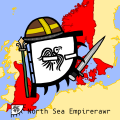North Sea Empire: Difference between revisions
| Line 31: | Line 31: | ||
== Religion == | == Religion == | ||
By the early 11th century, [[File:KOEngland-icon.png]] [[Kingdom of England|England]] had been [[File:Christianity-icon.png]] [[Christianity|Christian]] for centuries, and the [[File:Denmark-icon.png]] [[Danelaw]] was transitioning from [[File:NorsePagan-icon.png]] [[Norse Paganism|paganism]] to [[File:Christianity-icon.png]] [[Christianity]]. However, [[File:Kalmar Union-icon.png]] [[Scandinavia]] remained mostly [[File:NorsePagan-icon.png]] [[Norse Paganism|pagan]]. [[File:NorthSeaEmpire-icon.png]] [[Monarchy|Cnut]]'s father, [[File:Monarchy-icon.png]] [[Monarchy|Sweyn]], started as a [[File:NorsePagan-icon.png]] [[Norse Paganism|pagan]] but later became mostly [[File:Christianity-icon.png]] [[Christianity|Christian]]. In [[File:KOEngland-icon.png]] [[Kingdom of England|England]], [[File:NorthSeaEmpire-icon.png]] [[Monarchy|Cnut]] supported the Church, gaining acceptance from [[File:Christianity-icon.png]] [[Christianity|Christian]] rulers in [[File:EU-icon2.png]] [[Europe]], a recognition no previous [[File:Kalmar Union-icon.png]] [[Scandinavia|Scandinavian]] king had achieved. In [[File:KONorway-icon.png]] [[Kingdom of Norway|Norway]], he built churches and was generous to the clergy but also made alliances with [[File:NorsePagan-icon.png]] [[Norse Paganism|pagan]] chieftains. [[File:NorthSeaEmpire-icon.png]] [[Monarchy|Cnut]] didn't make Church-favoring laws until his rule was secure. | By the early 11th century, [[File:KOEngland-icon.png]] [[Kingdom of England|England]] had been [[File:Christianity-icon.png]] [[Christianity|Christian]] for centuries, and the [[File:Denmark-icon.png]] [[Danelaw]] was transitioning from [[File:NorsePagan-icon.png]] [[Norse Paganism|paganism]] to [[File:Christianity-icon.png]] [[Christianity]]. However, [[File:Kalmar Union-icon.png]] [[Scandinavia]] remained mostly [[File:NorsePagan-icon.png]] [[Norse Paganism|pagan]]. [[File:NorthSeaEmpire-icon.png]] [[Monarchy|Cnut]]'s father, [[File:Monarchy-icon.png]] [[Monarchy|Sweyn]], started as a [[File:NorsePagan-icon.png]] [[Norse Paganism|pagan]] but later became mostly [[File:Christianity-icon.png]] [[Christianity|Christian]]. In [[File:KOEngland-icon.png]] [[Kingdom of England|England]], [[File:NorthSeaEmpire-icon.png]] [[Monarchy|Cnut]] supported the Church, gaining acceptance from [[File:Christianity-icon.png]] [[Christianity|Christian]] rulers in [[File:EU-icon2.png]] [[Europe]], a recognition no previous [[File:Kalmar Union-icon.png]] [[Scandinavia|Scandinavian]] king had achieved. In [[File:KONorway-icon.png]] [[Kingdom of Norway|Norway]], he built churches and was generous to the clergy but also made alliances with [[File:NorsePagan-icon.png]] [[Norse Paganism|pagan]] chieftains. [[File:NorthSeaEmpire-icon.png]] [[Monarchy|Cnut]] didn't make Church-favoring laws until his rule was secure. | ||
Revision as of 20:27, 14 July 2024
The North Sea Empire, also referred to as the Anglo-Scandinavian Empire, was a personal union comprising the kingdoms of ![]() England,
England, ![]() Denmark, and
Denmark, and ![]() Norway. This union existed for most of the period between 1013 and 1042, towards the end of the
Norway. This union existed for most of the period between 1013 and 1042, towards the end of the ![]() Viking Age. The union was a
Viking Age. The union was a ![]() Thalassocracy, as the components of the union are only connected by sea. This maritime dominance allowed for control over the
Thalassocracy, as the components of the union are only connected by sea. This maritime dominance allowed for control over the ![]() North Sea and facilitated trade, military expeditions, and cultural exchanges among the territories. The most notable ruler of this empire was king
North Sea and facilitated trade, military expeditions, and cultural exchanges among the territories. The most notable ruler of this empire was king ![]() Cnut the Great, who reigned over the three kingdoms and managed to maintain a relatively stable and prosperous empire during his rule.
Cnut the Great, who reigned over the three kingdoms and managed to maintain a relatively stable and prosperous empire during his rule.
History
![]() Cnut the Great, originally a prince of
Cnut the Great, originally a prince of ![]() Denmark, became king after the death of his father, king
Denmark, became king after the death of his father, king ![]() Sweyn Forkbeard, in 1014.
Sweyn Forkbeard, in 1014. ![]() Sweyn had previously conquered parts of
Sweyn had previously conquered parts of ![]() England, and after his death,
England, and after his death, ![]() Cnut continued the campaign.
Cnut continued the campaign.
Name
Historians coined the term "North Sea Empire" at the beginning of the 20th century. However, the idea of ![]() Cnut's domains forming an empire dates back to 1623, as seen in
Cnut's domains forming an empire dates back to 1623, as seen in ![]() John Speed's Histoire of
John Speed's Histoire of ![]() Great Britaine. Historically, the union was referred to by his individual components: the kingdoms of
Great Britaine. Historically, the union was referred to by his individual components: the kingdoms of ![]() Denmark,
Denmark, ![]() Norway, and
Norway, and ![]() England.
England.
Religion
By the early 11th century, ![]() England had been
England had been ![]() Christian for centuries, and the
Christian for centuries, and the ![]() Danelaw was transitioning from
Danelaw was transitioning from ![]() paganism to
paganism to ![]() Christianity. However,
Christianity. However, ![]() Scandinavia remained mostly
Scandinavia remained mostly ![]() pagan.
pagan. ![]() Cnut's father,
Cnut's father, ![]() Sweyn, started as a
Sweyn, started as a ![]() pagan but later became mostly
pagan but later became mostly ![]() Christian. In
Christian. In ![]() England,
England, ![]() Cnut supported the Church, gaining acceptance from
Cnut supported the Church, gaining acceptance from ![]() Christian rulers in
Christian rulers in ![]() Europe, a recognition no previous
Europe, a recognition no previous ![]() Scandinavian king had achieved. In
Scandinavian king had achieved. In ![]() Norway, he built churches and was generous to the clergy but also made alliances with
Norway, he built churches and was generous to the clergy but also made alliances with ![]() pagan chieftains.
pagan chieftains. ![]() Cnut didn't make Church-favoring laws until his rule was secure.
Cnut didn't make Church-favoring laws until his rule was secure.
Gallery
-
Shaped



